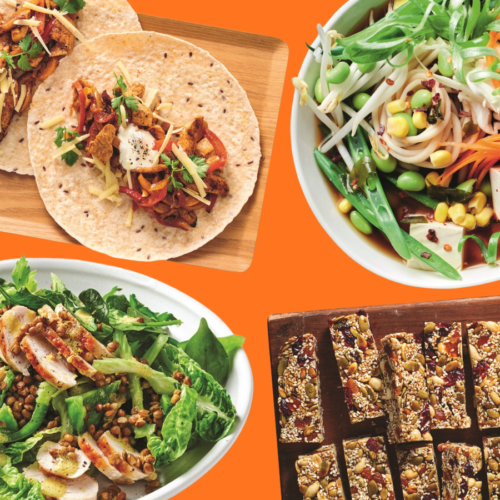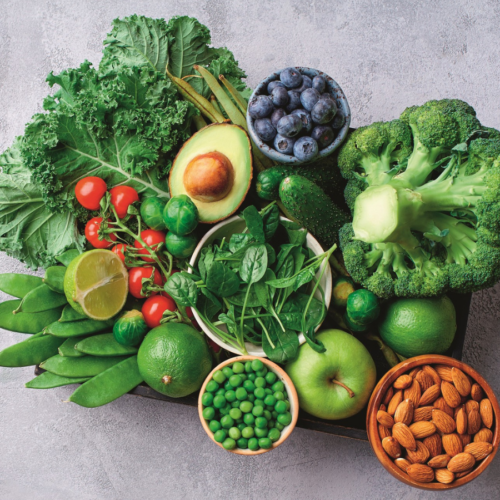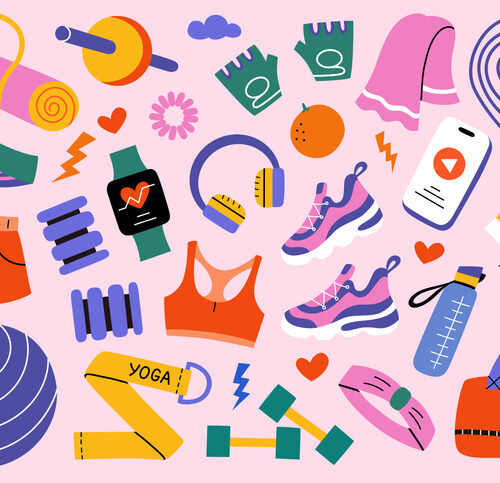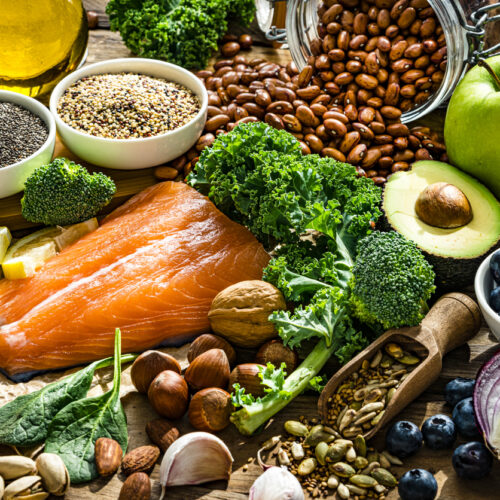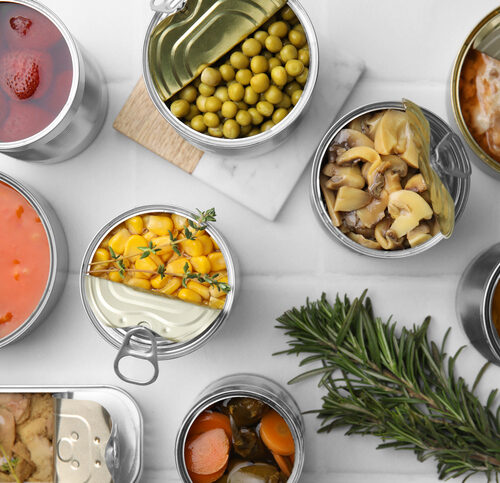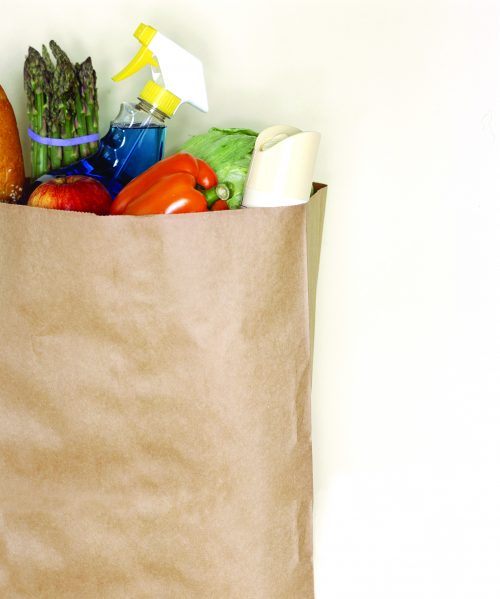
Beat the traps and become an expert healthy shopper! We take a walk around the supermarket aisles and give you advice on how to be a more savvy shopper.
Grocery retailing is big business. We spent $14.5 billion in grocery stores and supermarkets in the year to March 2009.
The supermarkets compete with one another to get us into their stores and coming back for more. And we shouldn’t be surprised that once we are in the store, they would like us to spend as much as possible. But while there may be offers to entice, and food to taste, no one is going to boot us out for shopping smart or spending to our budgets. Be assured, we will be welcome back next week; they need us just as much as we need them.
Some commentators accuse supermarkets of promoting unhealthy food choices. After all, we constantly see price promotions encouraging us to buy more biscuits, potato chips and sweetened drinks.
In reality, supermarkets are the intermediary. Manufacturers promote their products via the supermarket and pay for the privilege. Supermarkets are not in the business of trying to promote healthy or unhealthy foods. Their goal is simple, and the same as most other businesses – to maximise their profitability over the long term. So how do they do that? And what can we do to make sure we get what we want from the supermarket?
What’s on the shelf?
Walk into your local supermarket, and you will see that products are categorised into various segments (such as breakfast cereals). What you don’t see is the careful planning that goes into the positioning of each product. The goal of this planning is to maximise sales and profit from the category, which is why top-selling products are always placed at eye-level: we don’t like having to reach up or crouch down. Unfortunately, this means we won’t always choose the healthiest product.
Manufacturers always want more ‘facings’ for their products. The theory is the product will be more noticeable and have a better chance of being chosen. Also, there’s a limit to how often the shelf can be restocked, so we all – the manufacturer, retailer and customers – want enough packs on the shelf to last until the next restocking. So the number of facings a product has, compared to others in the category, is generally a gauge of its sales volume relative to the others.
The shelf layout plans for a category don’t stay in place forever. When new products are launched, the slower sellers have to make space for them. And customers’ preferences change, so the top seller three months ago may have been overtaken by another product.
- Researchers in the US tested the impact of eye-level position by moving toothbrushes from a top shelf to an eye-level shelf in 30 test supermarkets: sales increased by eight per cent.
- The same researchers found position was far more important than the number of facings. A couple of facings at eye level did more for a product than five facings on the bottom shelf.
Supermarket strategy
Look up and look down before you make your choice, as the best bargain might be out of your eye line.
How to influence what’s in store
The key determinant of what and how much of it is on the shelf, is what you and other customers choose to buy on a regular basis; supermarkets have no interest in shelf-warmers. While all supermarkets have a base range of products dictated by their head office, there is some discretion at store level and much more so in the owner-operated Foodstuffs stores. The same supermarket brand in different areas will stock different products as they want to cater to their local community. So if your supermarket doesn’t have what you want, tell them about it. (And then encourage your friends to buy it as well to keep it in stock.)
Sometimes it’s easiest to talk to the person in charge of the department, but you won’t always have time for that. At New World in Warkworth there is a ‘Customer Communication Board’ so you can jot down your query on the note paper provided and someone will get back to you (by phone, email or post). At Progressive stores it’s best to communicate with the store manager so they can pass it on to the head office buyers.
Supermarket strategy
If you can’t get what you want in the supermarket, let them know. They will respond to customer demand.
Promotions
Manufacturers fund price promotions in supermarkets and pay for the right to put their product on end-of-aisle displays. They get good sales increases from these promotions, hopefully more than enough to cover their costs. Some of us stock up on our favourite brand while it’s cheaper, others switch from their usual brand, and others always just buy what’s cheapest. Research from the US suggests 30 per cent or more of sales from these promotions are due to brand switching. Manufacturers hope once you have become accustomed to using their product, you will stick with them. There are, however, some categories where price promotion is so frequent, we consumers have been trained to expect to buy those products on promotion most of the time. Our gain! For supermarkets, the ideal is promotions also attract more shoppers into their store.
Do the numbers influence us? Brian Wansink, US researcher and author of Mindless Eating, gives a definitive ‘Yes’. After a number of experiments, he and his team found sales increased with virtually any type of ‘number’ promotion. Types of promotion included:
- Multiple unit pricing, eg. ‘six for $3′ sold more product than at the same promotion price of ’50 cents each’
- Quantity limits, eg. ‘limit 12 per customer’ increased sales
- Suggestive numbers, eg. ‘buy 12 for your freezer’ increased sales
- Even irrelevant numbers shifted more stock, eg. ‘shipped to stores in boxes of 14 units’.
Researchers tell us that having a stockpile of food at home makes that food more visible and more likely to be eaten in a greater amount. So buying two bars of chocolate because they’re on special may fall into the ‘not such a good idea’ category for many of us. On the other hand, having cans of tomatoes or chickpeas in the pantry might encourage us to make a healthy meal when we have a ‘what shall I cook tonight?’ moment.
Supermarket strategy
Before you buy more on promotion, stop. Think about whether you want to increase your consumption rate for this food.
Pack sizes
We expect larger pack sizes to be better value, and in many cases they are, but don’t assume that’s always the case. Often larger packs are priced at what retailers call ‘everyday low pricing’. This means that’s always the price, whereas the regular pack size might be promoted at a special price on a regular basis, and when this happens the regular pack is likely to be cheaper per unit or per 100g than the bulk pack.
It’s quite common for manufacturers to change:
- the size of the product, eg. making the crackers a bit smaller
- the pack count, eg. down to 22 units from 24
- the pack weight, eg. the product now weighs 350g, down from 400g.
These changes can be a way of making a price increase without having to draw your attention to it. It could also be a competitive manoeuvre, so the unit cost of their pack is less than their competitors’ pack. The risk manufacturers take is that when you notice the change, it might annoy you so much you decide to switch to another brand.
As manufacturers can’t keep reducing the size of their product forever, you may also see larger product sizes, pack counts, or weights appear. These generally do have a price increase with them, so the ‘now more’ offering is trumpeted. Unit pricing helps with comparisons.
Supermarket strategy
Before you buy a bulk pack, make sure you will save money rather than just fill the pantry or expand your waistline. If a product suddenly looks better value, double-check the content and compare with like products. Check the unit pricing where available.
The power of the list
Some of us become zombie-like in the supermarket. It’s not surprising, given we can be faced with in excess of 20,000 individual products, all packaged to compete for our attention, plus a variety of price promotions, in-store radio, and even advertising on the trolley. It’s no wonder our senses can be overloaded and ‘auto-pilot’ takes over. This may not be conducive to good decision-making.
Supermarkets are chock-full of temptation, so planning ahead is essential if we want to take control. Think of it this way: if we do our decision-making in-store, there is more opportunity for manufacturers and retailers to influence the decisions we make. Sometimes it’s great to find new products to try, but if we need to stick firmly to a budget, we need a strategy to avoid temptation. Planning helps us get through the maze and come out the other end with what we need, rather than what caught our attention. The starting point is the shopping list. Even better is meal planning for the week in order to create the list; and the high achievers amongst us create a price notebook, in which the prices of commonly-bought products are recorded so they know when they see a good price.
In their book Nudge, behavioural researchers Richard Thaler and Cass Sunstein talk about the concept of ‘choice architecture’ and how it can be used to improve decisions about health, wealth and happiness. Put simply, by making the best option the simplest or default option we choose it more readily. In our supermarket context this can be as simple as deciding what to buy before we enter the supermarket. So when we’re faced with a choice like ‘shall I buy that tub of ice cream or not?’, all we have to do is refer to the list: if it’s not on it, we don’t buy it. We’ve done our planning and thinking ahead of time; now the task it to get those products and move on.
Supermarket strategy
At the minimum write a shopping list: it really does save temptation, time and money. Make a side list of things you will buy only if they are on special. Even better, plan each week’s menu and write your list based on that.
The checkout
The checkout is a high temptation area. ‘Pester power’ is a concept well-known by marketers, retailers and parents alike. And while the kids find the confectionery at the checkout tempting when waiting in line, we adults are not immune either.
After observing more than 2800 people at the checkout, researchers from the US found purchases from the tempting range of products at checkout were often not made immediately, but the likelihood of a purchase increased with time spent in line. And no surprises for parents here, the presence of children significantly increased the likelihood of a purchase being made. But it’s not worth making us wait longer as a sales strategy. Retailers know that getting us through the checkout quickly will help gain our loyalty.
Foodstuffs’ policy is to have one-quarter of checkouts confectionery-free. Progressive supermarkets have one confectionery-free checkout in their stores; instead you will see products such as nuts, dried fruit and bottled water.
Supermarket strategy
If you’re prone to the checkout temptations, identify the confectionery-free checkouts in your store (they will be signposted) and aim to use them. And if they’re too busy, complain. The confectionery-free checkout is, after all, a response to demand.
Plastic bags
To encourage reduced usage of plastic bags, PAK’n SAVE (South Island), New World and Four Square are introducing a five cent charge for each plastic bag from August 2009. North Island PAK’n SAVE shoppers have already been paying 10 cents for plastic bags for some years. At this stage, Progressive have no plans to introduce a charge for plastic bags.
Do it yourself
There’s some clever innovation happening in supermarkets to make our lives easier. When you have a smaller shop, using the self-scanning checkouts may be quicker. These are now available in: 22 (of 39) New World stores and eight (of 9) PAK’n SAVE stores in the South Island; 8 (of 46) New World stores in the Wellington region; and 16 (of 47) New World stores in the Upper North Island. We can expect to see more of these in future.
In the Wellington region, the PAK’n SAVEs all offer a ‘shop and go’ option. Registered users pick up a scanner and scan items as they put them into the trolley. They can do price-checks as they shop and also see a running total of their spend. At the designated checkouts, their bill is calculated from the scanner, and they pay and go. There are a small number of random audits where the goods needs to go through the checkout, but the thousands of registered users obviously find this a quick and convenient way to shop.
Supermarket strategy
Learn to use the technology available in your store. It’s likely to save a lot more time in future.
Buying our loyalty
Supermarkets want us to keep coming back and their loyalty programmes are there to encourage that. Onecard is operated by Progressive and can be used in Woolworths, Foodtown and Countdown. Fly Buys can be used at New World stores.
Swipe the Onecard at the checkout to receive in-store specials. Purchases accrue points and three times a year a cash voucher is sent to those with enough points. Vouchers for special offers on products may also be sent, and because they are using data collected from each card, these are usually for types of products previously purchased. If you don’t have a Onecard or don’t have it on you, you don’t benefit from the Onecard specials. (There are lots of other specials that are available to all customers.) The Fly Buys website tells us if we spent $150 each week at New World we would get six points per visit and 312 points over the year.
It costs nothing to join either of these schemes so if you’re not a member, we recommend you sign up now. There’s potential for saving with Onecard, even if you don’t shop at the applicable supermarkets regularly, and FlyBuys is used by lots of other stores so you may just build up a useful amount of points even if you rarely shop at a New World.
Supermarket strategy
Become a joiner: you only stand to gain.
Supermarkets in New Zealand: The two big supermarket retailers in New Zealand are Foodstuffs, a New Zealand-owned co-operative which has 58% share of supermarket sales, and Progressive Enterprises which is owned by Australia’s Woolworths and has 42% share. Foodstuffs brands include New World, PAK’n SAVE and Four Square. These stores are all managed by the owners who are members of the co-operative. Progressive owns Foodtown, Woolworths and Countdown, and are also the franchise co-ordinator for FreshChoice and SuperValue.
Unit pricing means displaying the price of goods per unit of measurement, eg. the cost per 100g – great for making comparisons. All packaged goods in Progressive stores have unit pricing (except for items where it’s not appropriate, eg. brooms) as do most items in their fresh departments, except bakery. New World and PAK’n SAVE are developing the necessary software and plan to introduce unit pricing by mid-2010.
Running out of time? Shop at a smaller supermarket. A 2000 study showed that when shoppers are given the option of choosing among either six and 24 assortments of jam, they show more interest in the larger assortment. But when it comes time to pick just one, they’re 10 times more likely to make a purchase if they choose among six rather than among 24 flavours of jam! It seems too much choice is not a good thing.
Did you know?
- 86% of women look at price when they shop, but only 72% of men do.
- About 60-70% of all supermarket purchases are unplanned.
- Trolleyology is the term coined by American anthropologists to describe how we evaluate others by sneaking a glance in their shopping trolley.
- Supermarkets initially offered price-off fuel vouchers in the hope of encouraging our loyalty to them. But research from AC Nielsen found supermarket fuel vouchers had a stronger impact on where we bought our fuel than where we shopped for our groceries.
www.healthyfood.com


